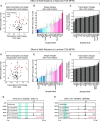Combining TSS-MPRA and sensitive TSS profile dissimilarity scoring to study the sequence determinants of transcription initiation
- PMID: 37403796
- PMCID: PMC10450201
- DOI: 10.1093/nar/gkad562
Combining TSS-MPRA and sensitive TSS profile dissimilarity scoring to study the sequence determinants of transcription initiation
Abstract
Cis-regulatory elements (CREs) can be classified by the shapes of their transcription start site (TSS) profiles, which are indicative of distinct regulatory mechanisms. Massively parallel reporter assays (MPRAs) are increasingly being used to study CRE regulatory mechanisms, yet the degree to which MPRAs replicate individual endogenous TSS profiles has not been determined. Here, we present a new low-input MPRA protocol (TSS-MPRA) that enables measuring TSS profiles of episomal reporters as well as after lentiviral reporter chromatinization. To sensitively compare MPRA and endogenous TSS profiles, we developed a novel dissimilarity scoring algorithm (WIP score) that outperforms the frequently used earth mover's distance on experimental data. Using TSS-MPRA and WIP scoring on 500 unique reporter inserts, we found that short (153 bp) MPRA promoter inserts replicate the endogenous TSS patterns of ∼60% of promoters. Lentiviral reporter chromatinization did not improve fidelity of TSS-MPRA initiation patterns, and increasing insert size frequently led to activation of extraneous TSS in the MPRA that are not active in vivo. We discuss the implications of our findings, which highlight important caveats when using MPRAs to study transcription mechanisms. Finally, we illustrate how TSS-MPRA and WIP scoring can provide novel insights into the impact of transcription factor motif mutations and genetic variants on TSS patterns and transcription levels.
© The Author(s) 2023. Published by Oxford University Press on behalf of Nucleic Acids Research.
Figures







Similar articles
-
Deciphering regulatory DNA sequences and noncoding genetic variants using neural network models of massively parallel reporter assays.PLoS One. 2019 Jun 17;14(6):e0218073. doi: 10.1371/journal.pone.0218073. eCollection 2019. PLoS One. 2019. PMID: 31206543 Free PMC article.
-
QuASAR-MPRA: accurate allele-specific analysis for massively parallel reporter assays.Bioinformatics. 2018 Mar 1;34(5):787-794. doi: 10.1093/bioinformatics/btx598. Bioinformatics. 2018. PMID: 29028988 Free PMC article.
-
Sequence-based correction of barcode bias in massively parallel reporter assays.Genome Res. 2021 Sep;31(9):1638-1645. doi: 10.1101/gr.268599.120. Epub 2021 Jul 20. Genome Res. 2021. PMID: 34285053 Free PMC article.
-
High-Throughput Analysis of Retinal Cis-Regulatory Networks by Massively Parallel Reporter Assays.Adv Exp Med Biol. 2019;1185:359-364. doi: 10.1007/978-3-030-27378-1_59. Adv Exp Med Biol. 2019. PMID: 31884638 Free PMC article. Review.
-
Massively parallel reporter assay: a novel technique for analyzing the regulation of gene expression.Yi Chuan. 2023 Oct 20;45(10):859-873. doi: 10.16288/j.yczz.23-180. Yi Chuan. 2023. PMID: 37872110 Review.
Cited by
-
Applications of high-throughput reporter assays to gene regulation studies.Curr Opin Struct Biol. 2025 Jun 27;94:103105. doi: 10.1016/j.sbi.2025.103105. Online ahead of print. Curr Opin Struct Biol. 2025. PMID: 40580800 Review.
-
Position-dependent function of human sequence-specific transcription factors.Nature. 2024 Jul;631(8022):891-898. doi: 10.1038/s41586-024-07662-z. Epub 2024 Jul 17. Nature. 2024. PMID: 39020164 Free PMC article.
References
-
- Shiraki T., Kondo S., Katayama S., Waki K., Kasukawa T., Kawaji H., Kodzius R., Watahiki A., Nakamura M., Arakawa T.et al. .. Cap analysis gene expression for high-throughput analysis of transcriptional starting point and identification of promoter usage. Proc. Natl. Acad. Sci. U.S.A. 2003; 100:15776–15781. - PMC - PubMed

